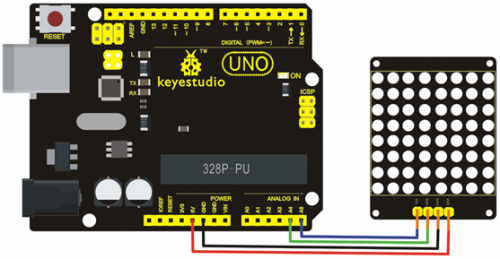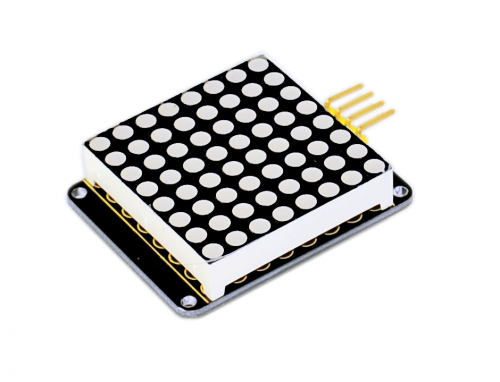Ks0064 keyestudio I2C 8x8 LED Matrix HT16K33: Difference between revisions
Keyestudio (talk | contribs) (Created page with "==Keyestudio I2C 8x8 LED Matrix HT16K33== <br>500px|frameless|thumb<br> ==Introduction== What's better than a single LED? Lots of LEDs! A fun way to mak...") |
Keyestudio (talk | contribs) No edit summary |
||
| Line 53: | Line 53: | ||
} | } | ||
</pre> | </pre> | ||
==Video== | |||
http://www.keyestudio.com/wp/2016/05/ks0064-keyestudio-88-i2c-led-matrix/ | |||
[[category:Module]] | [[category:Module]] | ||
Revision as of 16:07, 6 October 2016
Keyestudio I2C 8x8 LED Matrix HT16K33
Introduction
What's better than a single LED? Lots of LEDs! A fun way to make a small display is to use an 8x8 matrix or a 4-digit 7-segment display. Matrices like these are 'multiplexed' - so to control 64 LEDs you need 16 pins. That's a lot of pins, and there are driver chips like the MAX7219 that can control a matrix for you but there's a lot of wiring to set up and they take up a ton of space. Here we feel your pain! After all, wouldn't it be awesome if you could control a matrix without tons of wiring? That's where these lovely LED matrix backpacks come in.
The matrices use a driver chip that does all the heavy lifting for you: They have a built in clock so they multiplex the display. They use constant-current drivers for ultra-bright, consistent color, 1/16 step display dimming, all via a simple I2C interface. These 1.2" matrix backpacks come with three address-selection jumpers so you can connect up to eight 1.2" 8x8's together (or a combination, such as four 1.2" 8x8's and four 7-segments, etc) on a single I2C bus.
https://github.com/adafruit/Adafruit-LED-Backpack-Library
Specification
- Input volt: 5V
- Rated input frequency: 400KHZ
- input power: 2.5W
- Input curr: 500mA
Connection Diagram
This module carries I2C interface, so we need to comply with I2C protocol in usage and corresponding head files must be included and added into the library.
Below is the connection diagram between this module and Arduino controller:

Sample Code
#include <Wire.h>
#include "Adafruit_LEDBackpack.h"
#include "Adafruit_GFX.h"
#ifndef _BV
#define _BV(bit) (1<<(bit))
#endif
Adafruit_LEDBackpack matrix = Adafruit_LEDBackpack();
uint8_t counter = 0;
void setup() {
Serial.begin(9600);
Serial.println("HT16K33 test");
matrix.begin(0x70); // pass in the address
}
void loop() {
// paint one LED per row. The HT16K33 internal memory looks like
// a 8x16 bit matrix (8 rows, 16 columns)
for (uint8_t i=0; i<8; i++) {
// draw a diagonal row of pixels
matrix.displaybuffer[i] = _BV((counter+i) % 16) | _BV((counter+i+8) % 16) ;
}
// write the changes we just made to the display
matrix.writeDisplay();
delay(100);
counter++;
if (counter >= 16) counter = 0;
}
Video
http://www.keyestudio.com/wp/2016/05/ks0064-keyestudio-88-i2c-led-matrix/
